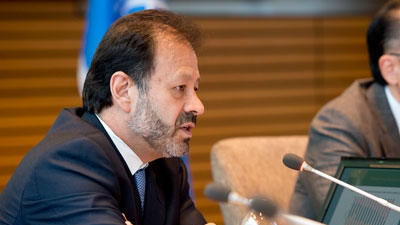China’s rise as a world power just over a decade ago caused “a tectonic shift” in the global economy that led to long-lasting change. The shift has even changed the language, says World Bank Chief Economist for Latin America and the Caribbean, Augusto de la Torre (Ecuador, 1953). New commonly-accepted terms have appeared, such as “emerging countries,” or BRIC (Brazil, Russia, India and China). Meanwhile, perceptions have also changed: the “North-South” divide or defining “Center” as the United States, Europe and Japan and “Periphery” as the remaining countries is no longer valid.
During this global sea change, which the World Bank analyzes in its latest report, Latin America and the Rising South: Changing World, Changing Priorities, coauthored by de la Torre, Latin America has also shifted its position. Like China, the region has become a key player on the new chessboard of powers. Nevertheless, some structural transformations have not yet been consolidated —infrastructure, human capital and trade expansion are the keys to the future— which are essential to avoid backsliding on the economic and social advances made over the past decade. There is still time to do so, according to de la Torre. But not much.
Question. According to the World Bank, China is at the epicenter of this global economic earthquake. Now its growth has slowed. Did Latin America trust too much in China as a driver of its economy?
Response. Whether we like it or not, when you experience a decade of this major change whose epicenter is China, people begin to think it is permanent. There was the illusion that those 10 years were going to last forever, but they did not. This is forcing the Latin American region to rethink its priorities and growth agenda.
Q. What are these priorities?
R. Improving infrastructure and also realizing that it is not only a question of being integrated, but how we are doing it. We have specialized heavily in raw materials; we have not implemented almost any process to diversify our exports. As a result of this specialization, Latin America has been less dynamic than other emerging nations in integrating global value chains. We now realize that these are an important driver of the economic growth of nations. Labor markets are also an issue: this is a new world where Latin America is too expensive to compete based on low wages. Additionally, skill levels and the number of engineers and experts are still insufficient for competing based on knowledge.
Q. How can exports be diversified?
R. In order for Latin America to take advantage of the new circumstances, it will need to find routes to guide its economic machinery toward the world of exports. The correlate of this is that it needs to be a region of greater savings. This is not currently the case. So Latin America is in a limbo of sorts; it has major challenges to be able to take advantage of the opportunities this new world offers. It needs to make these leaps in the quality of human and physical capital. Some progress has been made -- the region facing these challenges is not the one of crises of previous decades, but these are high-voltage challenges.
Q. Should Latin America have taken better advantage of the decade of bonanza?
R. After the soccer game, we are all experts on how it could have been played better. Now we are all aware that Latin America could have taken better advantage of those golden years: it could have saved more, could have invested more in human capital, could have better developed its infrastructure to support the diversification of exports, could have made more significant investments in reducing costs for developing productive projects…There is no doubt that all of this could have been improved. I do not believe that the region did as badly as some people think, but the pressure to resume these issues is intensifying to the extent that Latin America is feeling what it means to have less economic impetus from China.
Q. Is there still time to act?
R. In some ways, we have a little more time than before because during these boom years, Latin America has improved its macroeconomic policy, particularly its monetary policy. That will not necessarily lead to much more growth now, but it will certainly make the region less vulnerable. On the other hand, the region changed its social structure and experienced enormous progress. Now it has a larger middle class and fewer poor people. Consequently, it has generated high social expectations: Latin Americans became accustomed to the idea that their children had opportunities that their parents did not. From that perspective, there is not much time because the region and the political class are under pressure to improve the public services that a new social structure demands. Unfortunately, what needs to be done cannot be resolved in the short term. They are reforms that take time. We need to start immediately. We have a bit of relief because we are no longer threatened by the shadow of major macroeconomic crises; however, social expectations are much more acute than previously.
Q. In the report presented last week in Lima, the World Bank urged policymakers to rethink priorities “with a cold head.” What is the concern here?
R. Given the tension between societal expectations and resources and the current situation, there is a risk that Latin America will return to its populist tendencies of the past, to making short-term promises without broader horizons. It is an enormous challenge for politicians. But facing this challenge can give the region something that it sorely needs: leadership associated with a horizon and a vision of the future that is promising and that gets people excited, so that Latin Americans will be willing to make the effort now with a view to having a better future.

